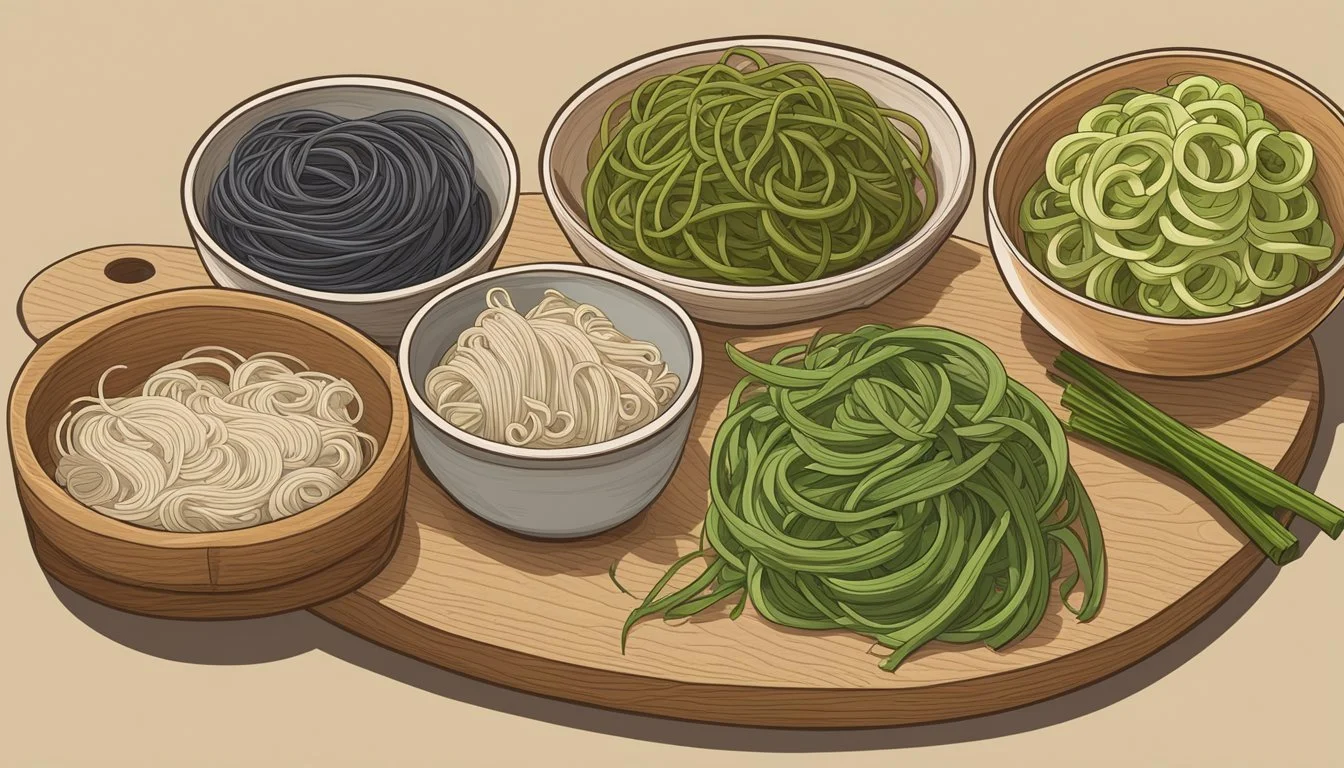Soba Noodles Substitutes
Top Alternatives for Traditional Buckwheat Noodles
Soba noodles, traditional Japanese fare, are revered for their unique texture and flavor, primarily attributed to their primary ingredient, buckwheat flour. This nutritious grain imparts a distinctive taste and health benefits, making soba a popular choice for those seeking healthier meal options. Unlike conventional pasta, soba noodles contain a higher percentage of protein and fiber and are often celebrated in dietary circles for their potential benefits to heart health and blood sugar control.
However, not all soba noodles are gluten-free, despite the common misconception. Pure buckwheat soba noodles do offer a gluten-free alternative, but many commercial varieties may include a mix of wheat flour and buckwheat flour, posing a concern for those with gluten sensitivities or celiac disease. When pure buckwheat flour isn't an option or soba noodles aren't readily available, individuals turn to substitutes to replicate the experience.
In the realm of substitutions, whole wheat spaghetti stands out as a favored option, offering a similar nutritional profile and a hearty texture reminiscent of soba. For those adhering to a gluten-free diet, alternatives such as gluten-free pasta made from grains like quinoa or rice can serve as suitable replacements, maintaining the healthful qualities sought in soba noodles while providing a similar culinary backdrop for a variety of dishes, from noodle bowls to stir-fries.
Understanding Soba Noodles
In the realm of Japanese cuisine, soba noodles hold a significant place with a rich historical context, a distinct nutritional profile, and versatile culinary uses.
Historical Context of Soba
Soba noodles have a storied past in Japanese cuisine, rooted in the country's culture for centuries. They are made from buckwheat, a plant with a notable resilience that allowed it to be cultivated in Japan's mountainous regions. Traditionally, soba is enjoyed on special occasions, symbolizing longevity and prosperity, and it remains a staple in Japanese dining.
Nutritional Profile
Soba noodles are esteemed for their nutritional value. They are a good source of protein, fiber, minerals, and vitamins. Here's a brief overview of their nutritional components:
Protein: Soba contains more protein than other refined noodles, making them a more satisfying choice.
Fiber: Buckwheat is high in dietary fiber, which aids in digestion.
Minerals: Including essential minerals such as magnesium and iron.
Vitamins: B vitamins, notably present in buckwheat flour, are abundant in soba noodles.
Culinary Uses
Soba noodles are incredibly versatile in the kitchen. They can be served chilled with a dipping sauce or hot in a Japanese noodle soup called soba broth. Commonly, soba noodles are incorporated into stir-fries, and they also make an excellent base for noodle bowls and salads. Their nutty flavor and resilient texture allow them to adapt well to various ingredients and cooking methods.
Identifying Suitable Substitutes
When choosing a substitute for soba noodles, it is important to consider the alternatives based on taste, texture, and cooking properties to maintain the integrity of the dish.
Criteria for Substitution
Substituting soba noodles requires attention to flavor compatibility and texture. Soba noodles have a nutty flavor and firm texture, often used in cold salads or hot soups. A suitable substitute should mimic these qualities and also maintain the dish's structure during cooking.
Common Soba Noodle Alternatives
Whole wheat spaghetti is a commonly recommended alternative, offering a firmer texture and higher nutritional content, inclusive of vitamins and fiber. Other wheat-based noodles such as udon and ramen noodles can be used; however, udon's thicker size and ramen's elasticity differ from soba's characteristics. For stir-fries, quinoa spaghetti and rice noodles provide similar textures, where quinoa adds a mild, nutty flavor, aligning more closely with soba noodles.
Gluten-Free Options
For individuals with a gluten allergy, rice noodles present a neutral flavor and adapt well to a variety of recipes, although slightly softer in texture. Other gluten-free substitutes include kelp noodles, which offer a crunchy texture and are rich in minerals.
Innovative Vegetable Noodles
Vegetable noodles are a novel and nutritious alternative. Zucchini noodles (zoodles), butternut squash noodles, and beet noodles can mimic the appearance and texture of soba when cooked al dente. They absorb flavors well and add a vibrant color with each vegetable bringing its unique taste to the dish.
Using these substitutions can yield dishes that honor the essence of soba noodles while also adding a personal touch or catering to dietary restrictions.
Preparing Substitutes
When seeking alternatives to soba noodles, one needs to understand the cooking techniques, seasonings, and methods of adapting them to various dishes. These factors will determine the success of the substitutions in replicating the unique characteristics of soba noodles.
Cooking Techniques
Substitutes such as whole wheat spaghetti or homemade buckwheat noodles should be boiled in water with a pinch of salt to enhance their flavor. Fresh pasta alternatives need attentive cooking; they should be cooked al dente to mimic the firm texture of soba noodles. For stir-fries and hot dishes, it's beneficial to undercook the pasta slightly since it will continue to cook when stir-fried with vegetables and sauces.
Seasonings and Flavor Enhancers
The unique umami and subtle earthiness of soba noodles can be emulated using a variety of seasonings. Incorporating soy sauce, ginger, and seaweed into recipes can enrich the substitutes with an umami depth. Light dressings using soy sauce, a hint of ginger, and a small amount of seaweed are especially suitable for cold dishes to bring out a flavor profile akin to that of soba.
Adapting to Dishes
Substitutes must be chosen based on the dish type:
For soups: A firmer pasta that retains its texture, such as whole wheat spaghetti, can withstand prolonged exposure to broth.
In stir-fries: Noodles that absorb flavors well, such as buckwheat-based homemade noodles, complement the technique.
For cold dishes: Opt for noodles that do not clump when chilled, ensuring that the dish remains appetizing and easy to eat.
One should always consider the end result when replacing soba noodles. Familiarity with the desired texture and flavor profile of the final dish is crucial for successful substitution.
Healthy and Nutritious Alternatives
When choosing alternatives for soba noodles, it's imperative to consider options that are rich in protein and fiber while maintaining a balanced carbohydrate profile. These alternatives offer both the nutty flavor characteristic of soba and health benefits, making them filling and suitable for various dietary preferences.
Picking High-Protein and Fiber-Rich Options
Whole-grain pasta emerges as a front-runner when seeking high-protein and fiber-rich substitutes for soba noodles. Unlike refined pastas, whole-grain varieties preserve the natural nutrients found in the grain's bran and germ. Whole grain pastas typically contain a favorable mixture of:
Buckwheat flour, if available, can be used to make homemade noodles that closely mimic soba's nutty flavor and nutritional content. Buckwheat is naturally high in amino acids, making it a good protein source, especially for plant-based diets.
Understanding Carbohydrates in Noodles
Carbohydrates are a primary energy source, but not all carbs are created equal. Soba noodles are traditionally valued for their complex carbohydrates, which provide steady energy release. Substitutes should ideally contain a low-to-moderate glycemic index. Options to consider include:
Whole-grain pasta: Contains complex carbohydrates.
Buckwheat noodles: An authentic alternative with similar carbohydrates to soba.
For those seeking a low-carb option, shirataki noodles can serve as a substitute. They are made from the konjac plant and are high in a type of fiber called glucomannan, yet low in digestible carbs. This makes shirataki noodles a less filling alternative but one that aligns with low-carb dietary goals.
Cultural and Regional Considerations
In exploring substitutes for soba noodles, one must consider the unique qualities each variety imparts due to its origins and the role it plays in regional cuisine.
Japanese Varieties
Japanese cuisine harbors a diverse array of noodles, among which soba is a staple. However, when soba is not available, yakisoba noodles provide a similar mouthfeel but are made from wheat flour, yielding a slightly different taste and texture. For a similar thinness but a lighter flavor, somen noodles serve as another alternative, traditionally enjoyed cold with a dipping sauce. Japanese markets commonly stock these varieties, making them accessible substitutes within Japanese gastronomy.
Japanese Soba Substitutes:
Yakisoba Noodles: Typically used in stir-fried dishes.
Somen Noodles: Lighter and thinner, usually served cold.
Other Asian Substitutes
Moving from Japan to a broader Asian context, other types of noodles can fill the role of soba. Korean buckwheat noodles share soba's main ingredient, offering a comparable taste profile. Rice vermicelli and cellophane noodles (made from mung bean starch), commonly found in Chinese and other Southeast Asian cuisines, offer a distinctly different texture and are often available in Asian markets. They are versatile, fitting well into an array of Asian dishes, from salads to soups.
Substitutes from Other Asian Cuisines:
Korean Buckwheat Noodles: A close relative to Japanese soba.
Chinese Vermicelli: Also known as rice vermicelli, lighter and thinner.
Cellophane Noodles: Translucent and gelatinous in texture.
Finding Soba Noodles and Alternatives
Soba noodles, a staple in Japanese cuisine, are renowned for their versatility and health benefits. This section will guide the reader through the ins and outs of locating soba noodles and creating suitable alternatives, whether one is cruising supermarket aisles or crafting a homemade version.
Retail and Supermarket Tips
When searching for soba noodles in a supermarket, it is advisable to first visit the Asian or international foods aisle. Soba noodles may also be found under the label of Japanese noodles. Shoppers should keep an eye out for labels indicating 'soba,' which is traditionally made from buckwheat flour.
For those seeking a replacement, supermarkets often carry various substitutes that maintain the spirit of soba noodles in both taste and nutrition. These substitutes include:
Whole-grain pasta: A convenient alternative that works well for stir-fries and noodle bowls.
Whole wheat spaghetti: Its brownish color is reminiscent of soba noodles and can be a suitable switch, especially in yakisoba-style dishes.
Homemade Substitutes
Individuals may opt to make homemade soba noodles for a fresh, personalized experience. To craft these, one will need:
Buckwheat flour: 1 cup
Hot water: Approximately 140ml
Spelt flour (optional): ½ cup for a traditional texture
Combine the buckwheat flour with the hot water, and, if desired, add in the spelt flour. Knead the mixture into a consistent dough, adjusting with extra flour or water if needed. This process results in fresh, homemade soba noodles that are high in nutrition and can be customized to taste.
Conclusion
Substitutes for soba noodles are plenty, each with unique characteristics to suit different dietary needs and culinary contexts. Whole wheat spaghetti stands out as a nutritious choice, rich in fiber, vitamins, and minerals, with a robust texture. It is a commendable alternative in stir-fries and noodle bowls, given its similar nutritional profile to soba noodles.
For those seeking vegan options, rice noodles and cellophane noodles are suitable as they contain no animal products. They maintain a similar texture and can seamlessly integrate into a range of dishes from salads to soups. Additionally, their versatility makes them an affordable and accessible option for many consumers.
Udon noodles, ramen noodles, and vermicelli can also replace soba noodles effectively. They each offer a distinctive flavor and texture that can enhance the dish. When substituting, one should pay attention to cooking times and methods, as they can vary significantly from soba noodles.
In selecting an alternative to soba noodles, consider the nutritional content and whether the substitute aligns with dietary preferences or restrictions. The following table summarizes the attributes of each substitute:
Substitute Texture Vegan-Friendly Nutritional Benefits Whole Wheat Spaghetti Robust Yes High in fiber, vitamins, minerals Rice Noodles Light, Chewy Yes Low in calories, gluten-free Cellophane Noodles Transparent, Soft Yes Low in fat, gluten-free Udon Noodles Thick, Chewy No High in carbohydrates Ramen Noodles Springy No Varied nutrition based on type Vermicelli Thin, Delicate Typically Yes Low in calories, often made from rice flour
The key is to choose a soba noodle substitute that not only mimics the texture and complements the flavors of the dish but also aligns with personal dietary needs and culinary goals.






